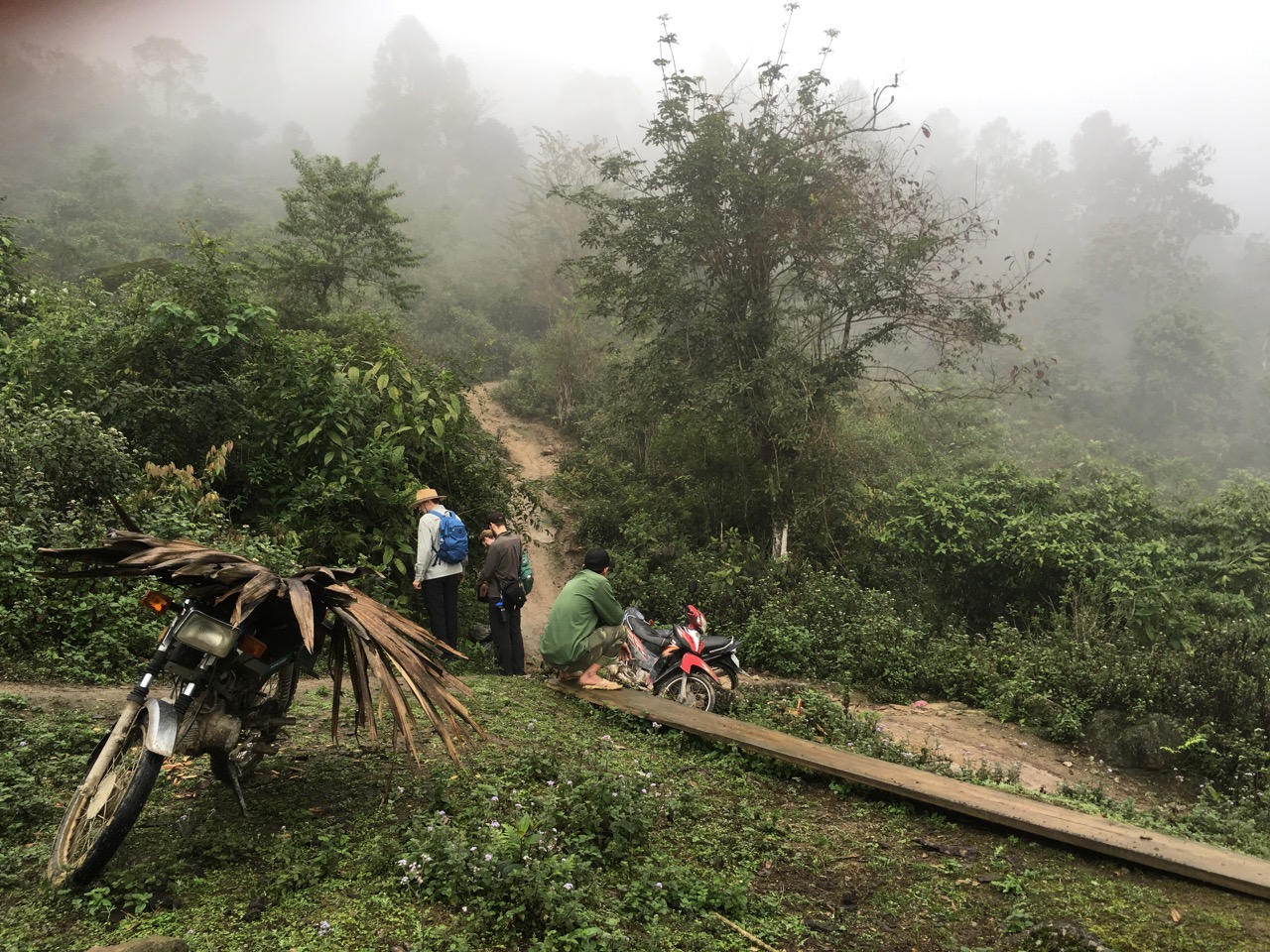
Day 1, 2 and 3 (March 29, 30, 31)
We arrived in Hanoi and settled into the now familiar Danly Hotel, shepherded by Nguyen Van Du our regular host from the Institute of Ecology and Biological Resources (IEBR), which is part of the Vietnam Academy of Science and Technologies, located at Hanoi University. Du is a botanist attached to the Ethnobotany Department in the IEBR. His expertise is in the Araceae (Arisaema, Colocasia, Amorphophallus, etc.). All of our accommodation and travel within Vietnam is organized by Du. The hotel is handy to the airport as well as to the university and the IEBR where we were all to meet up with Du, his assistant Bui Hong Quang and grad students, Trân Đúc Bình and Doan Hoang Son, who would be again accompanying us in the field for the next two weeks. The western contingent of our exploration team includes Andy Hill (UBC Botanical Garden), Dan Hinkley (Heronswood Garden), Thomas Robichaud-Courteau (Université de Sherbrooke), Dan Crowley (Westonbirt Arboretum) and me. Because the Danly is a thirteen-story hotel, it gives us plenty of opportunities to practice going up and down the stairs for a couple of days (good training drills for steep hills ahead). At Hanoi University the next day we met with the Director and the Head of International Programs for the IEBR. The meeting was organized to clarify roles and expectations for our current and ongoing work in Vietnam, and all parties came away better informed. We were interested to know who else was collaborating with the IEBR, for example, and were assured that a list of partners and projects would be forthcoming. We left Hanoi on our third day and headed north toward Ha Giang, a province in the far north noted for its spectacular limestone mountains and otherwise sublime scenery (it is a favoured area for eco-tourists). We stopped at a hotel (across the road from a very loud Karaoke Bar) in a small town about 20 km south of Ha Giang.
Day 4 (April 1)
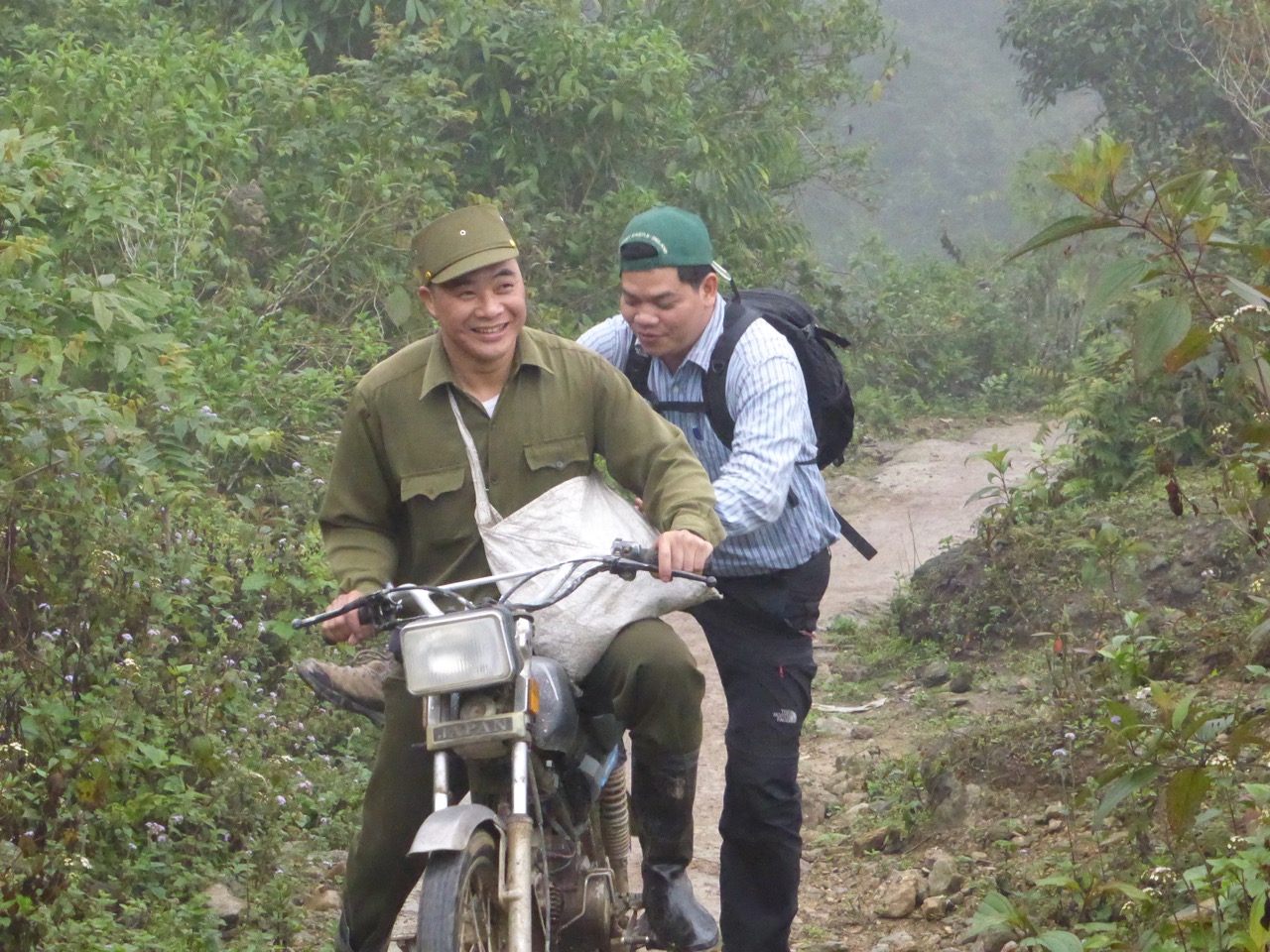
Quang dismounting from a motorcycle
We had breakfast in town then headed out into the mountains directly to the west, above the town. We drove for about an hour and a half, up and up and up until we ran out of navigable road, in a little village. It had been arranged earlier for motorbikes to be available. We didn’t get to drive them—each of us got on the back of a bike, and a driver (someone with nothing better to do in the village) drove us up the muddy, rutted, steep, switch-backing track for about 8 km. Then once it became too steep for the motorcycles, we got off and walked. It would have taken us hours longer if we hadn’t had the bikes, but riding on the back of a motorcycle is not something I would recommend under the best of conditions. And I would call these particular conditions somewhat harrowing.

Acer campbellii aff.
It started out misty, but then it got pretty rainy, which made much of the trail basically a mud-pit. This made our on-foot ascent exhausting and our descent very slow and slippery. Getting off the trail was often advantageous—at least it was not so slippery, and there were interesting plants to look at—but there were plenty of leeches in the underbrush, as we soon discovered. Luckily, not too long after lunch we actually found what we were looking for, at about 1350 m: “Acer campbellii affinity” (we’re not really sure what to call it at this point). This is a giant tree, probably 30 m tall, with a bole about 75 cm in diameter at the base, and with leaves looking essentially like those of the maples we had previously seen on Five Fingers and Y Ty (deeply five-lobed and purple when young and purple backed). We were happy to discover this, as it suggests this entity widespread in the mountains of northern Vietnam, at least. It was too wet to fly the camera-drone to see if there were flowers (let alone fly the cutting drone) and we certainly couldn’t see any detail beyond about 3 m in front of us because of the mist and rain, so we had to make do with examining seedlings, of which there were numerous examples, and looking at murky pictures. On the way up we made a few herbarium collections, but the flora was pretty tropical and the species mostly commonplace. Had the conditions been better, we would have continued ascending. The top of this mountain is evidently very rich in temperate plants like rhododendrons, but we would have been tempting fate to continue upwards.
We’re heading about 60 km north tomorrow, into a limestone area and closer to the Chinese border.
Day 5 (April 2)

Quang and Thomas high on a steep, limestone-boulder-strewn slope newly cleared for planting crops.
Today we spent most of the day getting to a small village and forestry station about 60 km northeast of Quan Ba (where I’m writing this). The ranger assigned some uncomfortable looking underling to show us the way up the mountain directly behind the station. Nice guy, but I’m not sure he was really very happy about having to hang around with us and unexpectedly work off a couple of thousand calories climbing the mountain. The hills here are exceptionally steep (even steeper than normal). There are karst-limestone formations jutting out everywhere. This makes for reasonably good clambering and climbing (lots of handholds), but the rocks are quite sharp, so one has to be careful. After proceeding nearly straight up for an hour we found a few Acer tonkinense (actually, the forestry guy found the first one). This was very exciting! I’ve never seen this maple in the wild before. We searched around for a tree with flowers or seed, but to no avail. It turns out that A. tonkinense is probably a fall-blooming maple. Fruit, if there had been any, might already have been shed, but it was more likely that the absence had to do with the age of the trees. There are no trees larger than about 4 or 5 m tall on the accessible slopes, as the local hill people repeatedly prune everything within reach for wood (for cooking) and fodder (for their livestock). Speaking of which, after straining uphill for a couple of hours we started to hear the sound of children’s voices. Three kids—pre-teens—were cutting branches of all kinds of plants, and tying them up into huge bundles. Depressingly, they appeared to be able to carry these enormous loads downhill at a jog. Meanwhile, we were reduced to picking our way step by painful, jarring step, concentrating on each, lest we slip or trip.
I am definitely knackered after that experience. It’s clear that I did not do enough training at the Danly, or indeed, before arriving in Vietnam.
Day 6 (April 3)
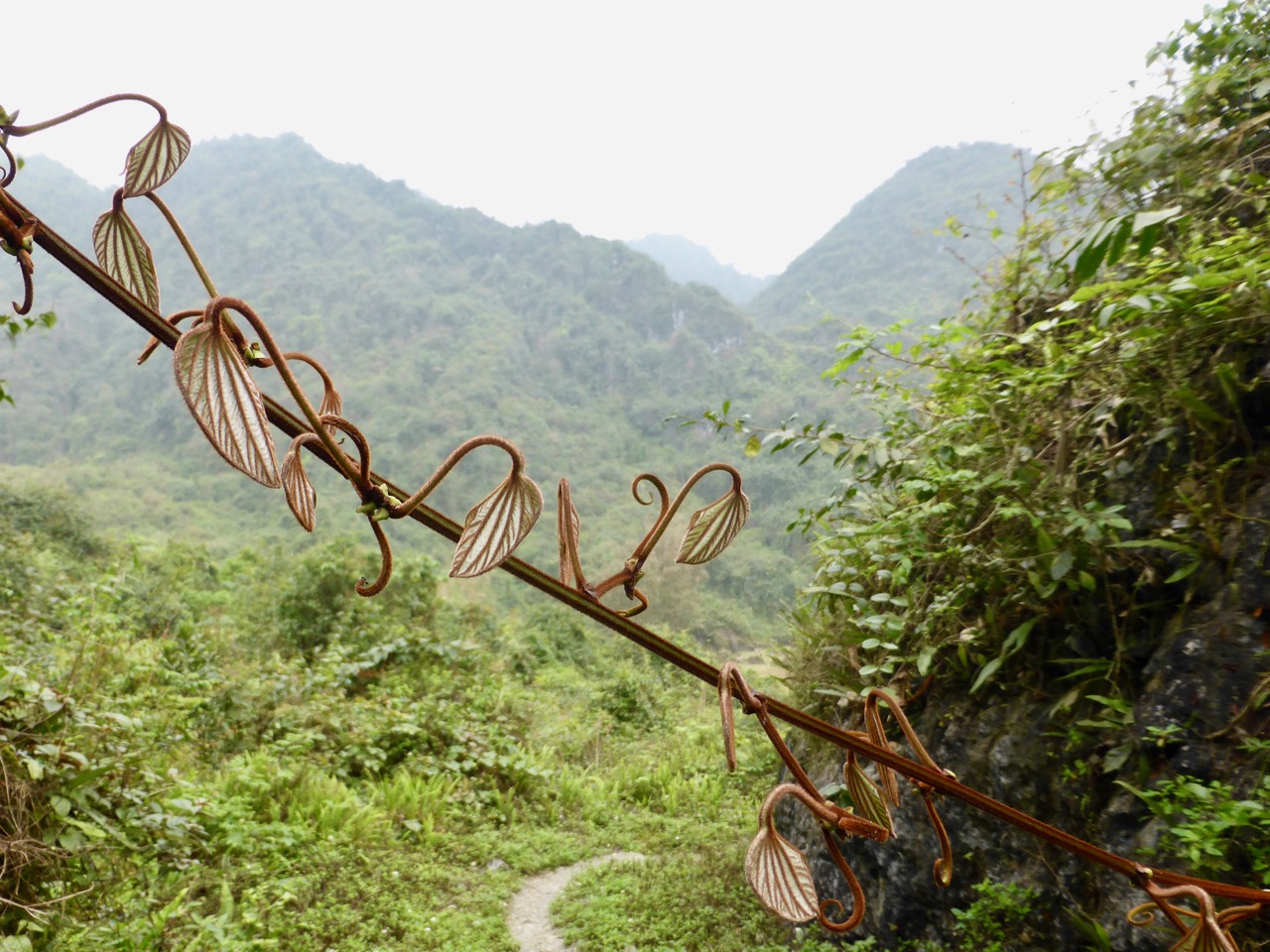
Bauhinia sp. outside Quan Ba
Let me tell you about the 567 Motel in Quan Ba. The rooms run from the front to the back, so the main street is right outside my front door. The building is set back from the street, with three-story walls of the adjacent buildings creating sounding boards on either side, which concentrate and amplify all of the noises from the street. In Vietnam (like most of the world), everyone in a vehicle has a horn. Horn honking is employed to warn people that a vehicle is about to overtake or before entering a blind corner. Unlike in Canada, the concept of a road lane is more fluid, so there is nearly constant overtaking—everybody is weaving in and out, entering into the stream without looking, and stopping wherever it suits. Bicycles overtake pedestrians, motor scooters overtake bicycles, more powerful motor scooters overtake slower motor scooters, buses overtake cars, truck, buses, etc. This happens regardless of time of day. Curiously, everyone on the main street blows their horn precisely as they pass the 567 Motel.
The back door of my room looks out over a few houses and apartments (or it would if I could open it). It looks like nearly everyone back there has a small or larger garden plot and there are lots of chickens. Directly behind the motel is an enormous dovecote and just to the left, a couple of doors down, a kennel. I didn’t know about any of this stuff out the back until we checked it out this afternoon, but from about 4:15 this morning there was a random, but more or less constant din of barking dogs, roosters crowing, pigeons cooing, horns honking, people yelling and trucks gearing down. At one point during the night, I’m sure the people in the room directly above mine dropped about two dozen metal cups on the tile floor.
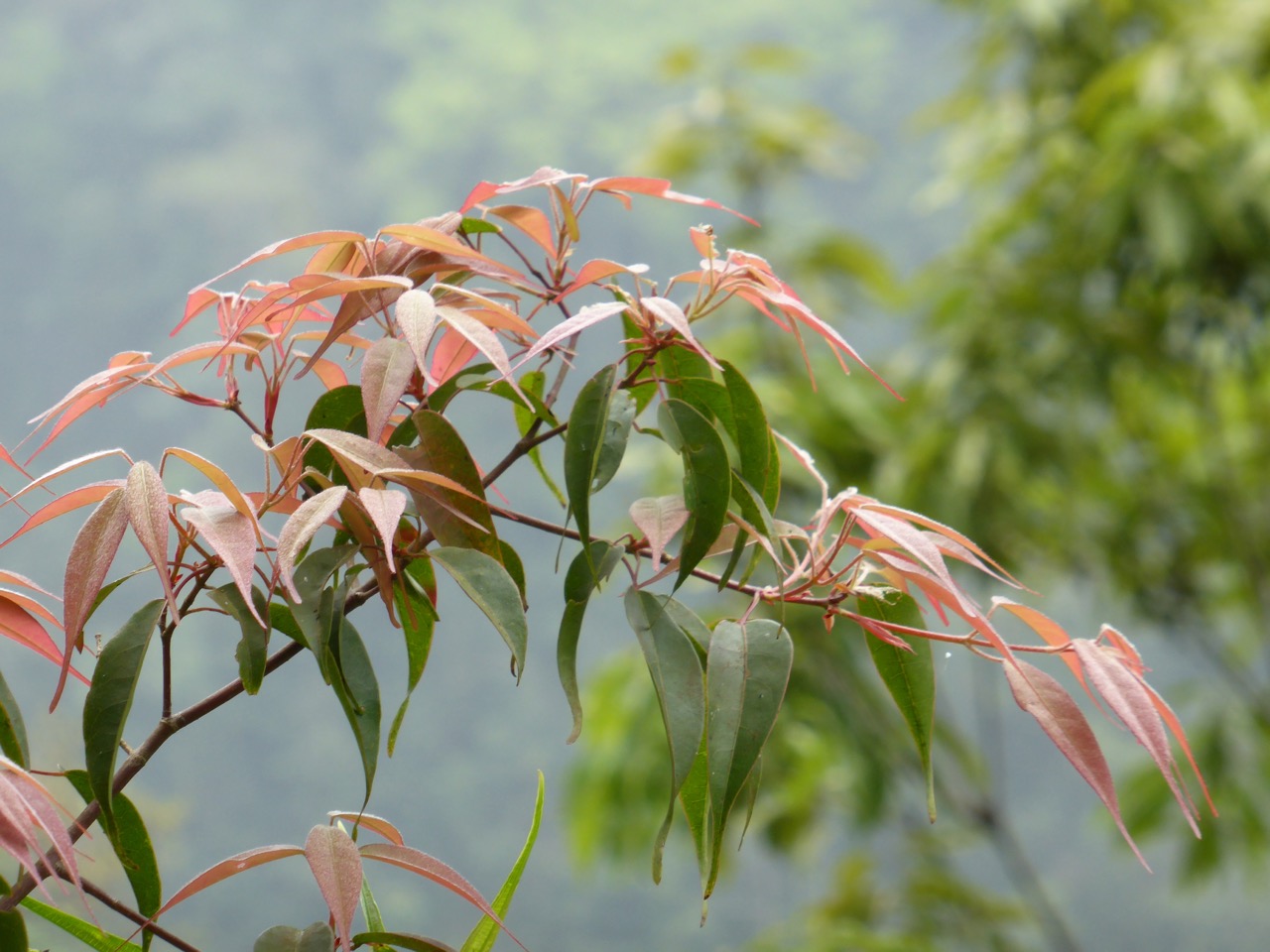
Acer laevigatum aff.
Today we had a great walk. After pho, we headed to the outskirts of Quan Ba and headed on foot across the fields toward the hills. This valley has a pair of famous hills that can be seen from various viewpoints around. They are known (somewhat obliquely) as the fairy bosom (the background is a must-read). These were not the hills we climbed. Anyway, we had a nice time looking at the lush greenery and karst landscape from the path, which climbed gradually for a few hundred meters elevation. We saw more examples of Acer tonkinense at this elevation (about 900m) but decided to continue up a steeper track toward the top of the ridge where we could see a large tree that we presumed was a conifer (the more familiar temperate conifers are only found at higher elevations). We struggled up the trail, which eventually ran out toward the ridge-top at about 1150m. Fumbling around in this dense brush, we happened upon two maples (A. laevigatum and what we presume is A. oblongum), and three conifers (a beautiful, very broad-leaved podocarpus relative, known as Nageia), a Taxus (yew) species and our large conifer, which turned out to be Pseudotsuga sinensis or Chinese Douglas fir (this would be var. brevifolia to some botanists). Lovely it was, but impossibly dangerous to climb to gather cones. We found a smaller tree nearby from which we collected a branch for the herbarium collection.

Village near Ban Ma
We were picked up later in a village at the other end of our original trail. It was a very small, picturesque Dao (the local hill people) village with lots of women and a few older men in traditional dress. We had lunch here (our usual squished buns, soft cheese—those foil-wrapped triangles with the laughing cow—and canned tuna and Spam-like meat. I could have killed for a piece of fruit, but we’ve not been using porters, so there is some reluctance to weigh ourselves down with extra food. The van had arrived, Thomas and the rest of us decided to give the “cutting drone” a spin. This is of course why Thomas is here with us—to try the drone under real-life conditions. After a couple of attempts, we had success cutting a branch with flowers and fruit off the top of a tree, about 10 m off the ground. It was a cultivated Azadirachta indica (neem) tree in the village, but it was a good subject for the cutting drone and everyone was pleased with the result.
Had some laundry done today while we were out. Unfortunately, it’s all air-drying around here, and the humidity is so high that the cotton stuff is still pretty damp. Luckily, I have a fan in the room, which I’ll leave on. Maybe it will drown out some of the other noises.
The power went out at about 8:00, so my laundry didn’t really dry at all. And I forgot to mention mooing cows.
Day 7 (April 4)
We had another good day in the mountains near Ha Giang. This time we were in the area known as Yen Minh, about 60 km away from Quan Ba. The morning’s excitement was driving up was explained as the “new road” from a village that I can only guess was Yen Minh. New road? How about not quite finished road? We were no more than 100 m up the road when we got hung up on a rock, blocking all vehicles other than motorbikes from passing. Our van is pretty loaded down at the best of times with the ten of us (driver, Dzu, Bing, Quang, Son, Andy, Dan C., Thomas, Dan H., and me) and all of our luggage and supplies, but we also had a local man on board to show us where the hike in question would start. Anyway, we got the van going after about a half an hour of work (Bing, Son and the driver actually did the work) and the traffic started to flow again.
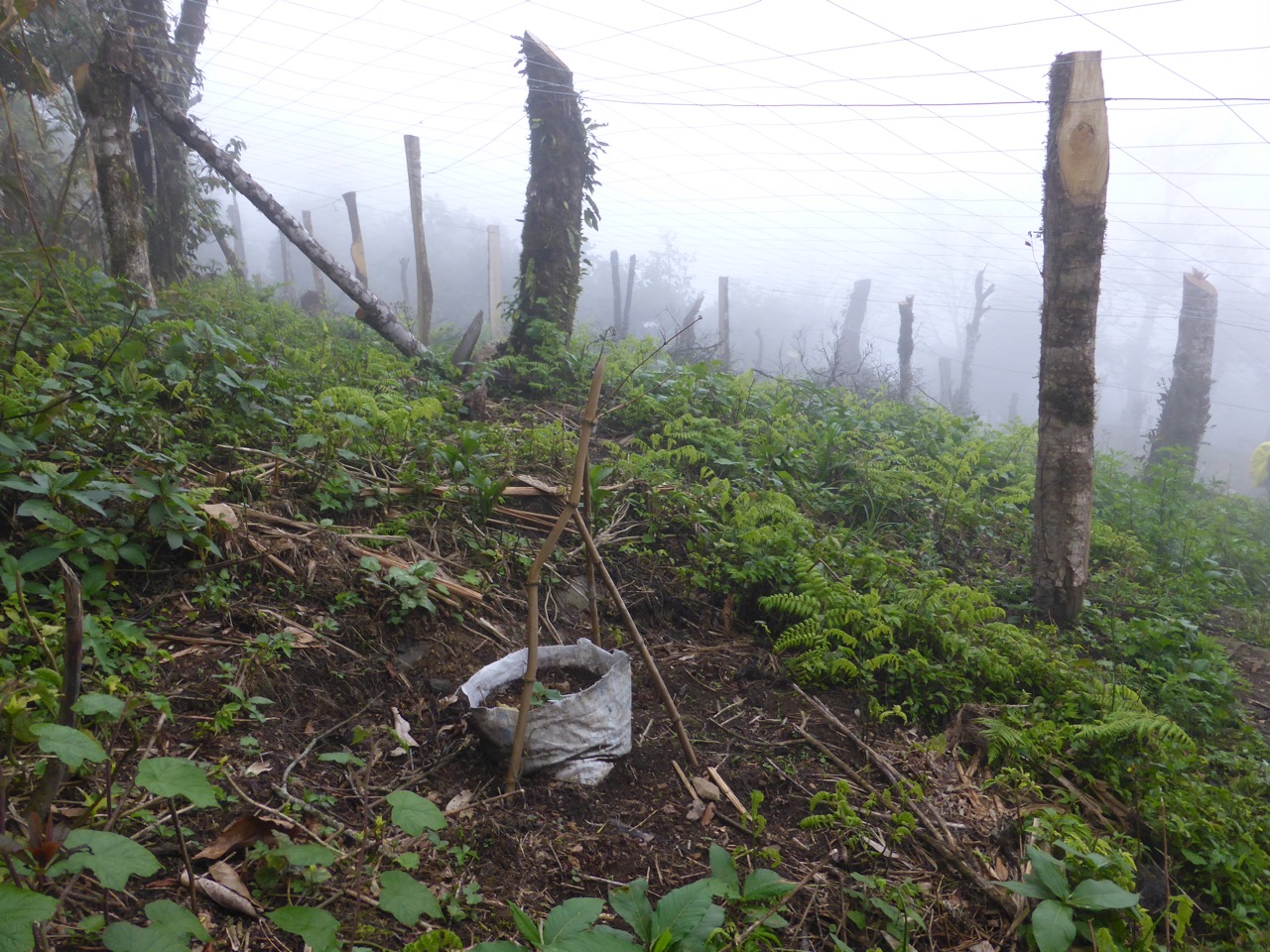
A squash plantation in Ban Qua
After driving for forty minutes or so, we got to the appropriate starting place (naturally, at the bottom of a hill). We commenced the slow grind up another impossibly steep limestone slope. All of these trails we’ve been on seem to be associated with traditional (possibly historical) paths up into the forest where the hill people cut firewood and fodder. Below the forested mountain tops they cultivate as much of the land as possible. We generally see corn, sugarcane, beans, cabbages and other cole crops, and today we saw Cannabis seedlings sprinkled about (this was a sensation for a few in the group). The fact that they can grow crops on these steep, boulder strewn-slopes, let alone continue up into the forest on a regular basis, is a revelation to most of us. It’s also troubling, as it appears more and more of these slopes are being cleared for crops. And in the accessible places above the crop areas (I have some difficulty calling them fields) there seem to be few if any mature, seed-producing trees. It’s obvious that the population (of people) is increasing in these parts, and that they are getting better medical care and nutrition. People all look pretty robust. There is better transportation (new roads and lots of motor bikes) and the farmers have better implements and technology (we saw farmers using buffalo-pulled ploughs, but also saw a number spraying herbicides using backpack sprayers). One can’t fault people for trying to improve their lot by doing more, where they can. It’s about survival, but I really fear for the land and the biodiversity.
We did see some fantastic scenery with mist and clouds blowing by us and in and out of the valley below. The IEBR folks made about twenty collections, but the rest of us were mostly focused on maples, as usual. We saw the largest Acer tonkinense, A. laevigatum (in flower) and A. oblongum we’d seen. The biggest trees were perched precariously over more or less sheer drops. There were cut-back trees of all of the Acer species—too many to count—the maples appearing to be the most favoured of all plants (probably for the wood), and we saw more variation within the species and more plants overall. For conifers, we also saw a few small Nageia and a couple of larger Pseudotsuga again. We also ran across a small Keteleeria (related to Pseudotsuga), but there were no cones, so it was not collected. Our glee was tempered somewhat knowing that this was our last opportunity to find Xanthocyparis and Amentotaxus, two exceptionally rare conifers native to high elevations in these limestone mountains. Sadly, we didn’t see them, but in retrospect, we were probably searching in areas with too much rainfall.
We trekked down the hill and back to van in the early afternoon and stopped at a small village where we had lunch. There were all kinds of orchids on display and for sale. They were obviously wrested from the forests all around. It’s sad knowing and seeing that the biodiversity is disappearing before our eyes. But who can blame people for trying to get ahead. The “necessities” we take for granted every day (clean water, education, garbage collection, sanitation, food availability, regular salary, social safety net) are so far outside the realm of possibility for some of these people, it’s a sobering reminder of our environmental bias and cultural hubris.
Day 8 and 9 (April 5, 6)
We arrived in Sapa (Lao Cai Province) yesterday after a fairly grueling drive from Ha Giang. Although the scenery was spectacular, the roads were mostly jarring and the drive altogether too long. The highlight was an excellent meal at a truck stop en route. In Sapa Town, we were again installed at the Mountaineer Hotel, where our affable, enthusiastic host Uoc Huu Le, welcomed us with his usual combination of puckish good-humour and obvious pride. “Did you take a hot shower? There is no end to the hot water here!” This is almost true.
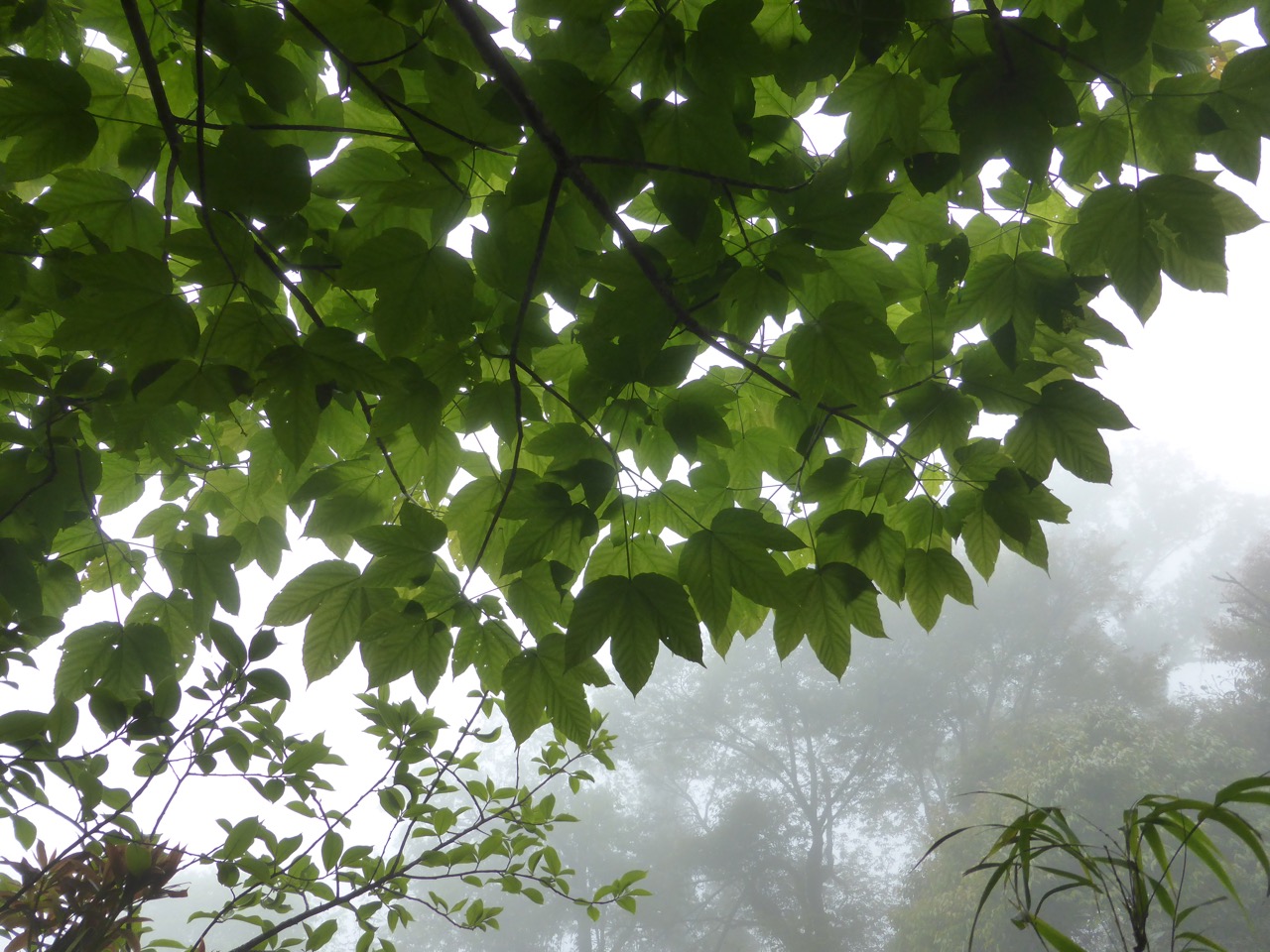
Acer sterculiacium near Ban Qua
We were to get an early start on Day 9, but after much post-pho to-ing and fro-ing, we decided to forego our original plan, which was to take the cable-car to Fansipan and hike back down the mountain (a six- to eight-hour hike). Our plans changed because of the threat of rain, as a wet Fansipan trail would be rather more challenging than if it were dry. Instead we settled on a hike up the mountain from the village of Ban Qua, about 9 km away. Most of us had been here two years before, when the black cardamom had been frosted and dead leaves were lying on the ground everywhere (for an explanation of the cardamom situation, see Exploring the Rooftop of Vietnam). The reason for revisiting the site was to see the Aesculus assamica. In Vietnam trees are particularly large fruited. Plants in cultivation in the west from this population are generally known as A. wangii (Wang’s giant horse chestnut), but the name has never been validly published and some question as to whether the Vietnamese plants differ appreciably from the typical forms of the species. There is also an enormous diversity of maples in this locale. This year, the cardamom leaves were well over all of our heads. Uoc led the charge up from the road, through the farmstead and up the steep slopes above, easily darting between the cardamom clumps and under the leafy canopy. Those of us over 1.5-m-tall had to duck and weave to negotiate the verdure, all the while getting tied up in the sprawling stalks and being repeatedly slapped in the face by the wet leaves. I spent most of my time listening for Uoc, because I definitely couldn’t see the route he was nimbly following along the muddy side-hill.
We arrived at the site of the horse chestnuts fairly smartly and quickly decided that since the weather was fair, that we would have Thomas set up the fly-cam drone, so that we could have a look at the flowers near the top of these 25-m-tall trees. This worked beautifully (as the video shows), so Thomas decided to give the cutting drone a whirl. Thomas is an engineering graduate student working on his Master’s degree in the laboratory of Alexis Lussier-Desbiens at the Université de Sherbrooke (Quebec, Canada). Thomas accompanied us to Vietnam two years previous with a prototype cutting drone, and he and Alexis have been working hard on this project, and the current drone has been improved with a number of bells and whistles (including so that it can remain stable while flying in in the wind, and cut and grab more effectively). Thomas was working on a steep bank in the middle of a cardamom patch, not a ideal space for setting up and operating a drone. The area had to be sufficiently cleared of debris and potentially interfering stems and leaves, and be big enough for the four people supporting Thomas with the operation of the drone. Under ideal conditions, it usually takes him fifteen minutes or so the put all the pieces together and test that all of the controllers and equipment are working. This gave Dan Crowley (“Maple Dan”) and me an opportunity to scout the area for maples. Just above us on the slope we found growing together specimens of Acer laevigatum (although a form of that species with a completely different appearance than what we’ve been seeing—so much so, that we’re considering that the two might deserve different names), a beautiful red-leaved A. sikkimense, a classic looking Acer campbellii (i.e., not like the A. campbellii affinity we’d seen on Day 5 or in previous years on Y Ty and on Five Fingers) and a ridiculously robust A. sterculiaceum (nearly like our native A. macrophyllum, with giant, 30-cm internodes and platter-like leaves), a species not even reported to be present in Vietnam. We saw many of all of these trees throughout the morning, marveling anew as we encountered larger and larger specimens.
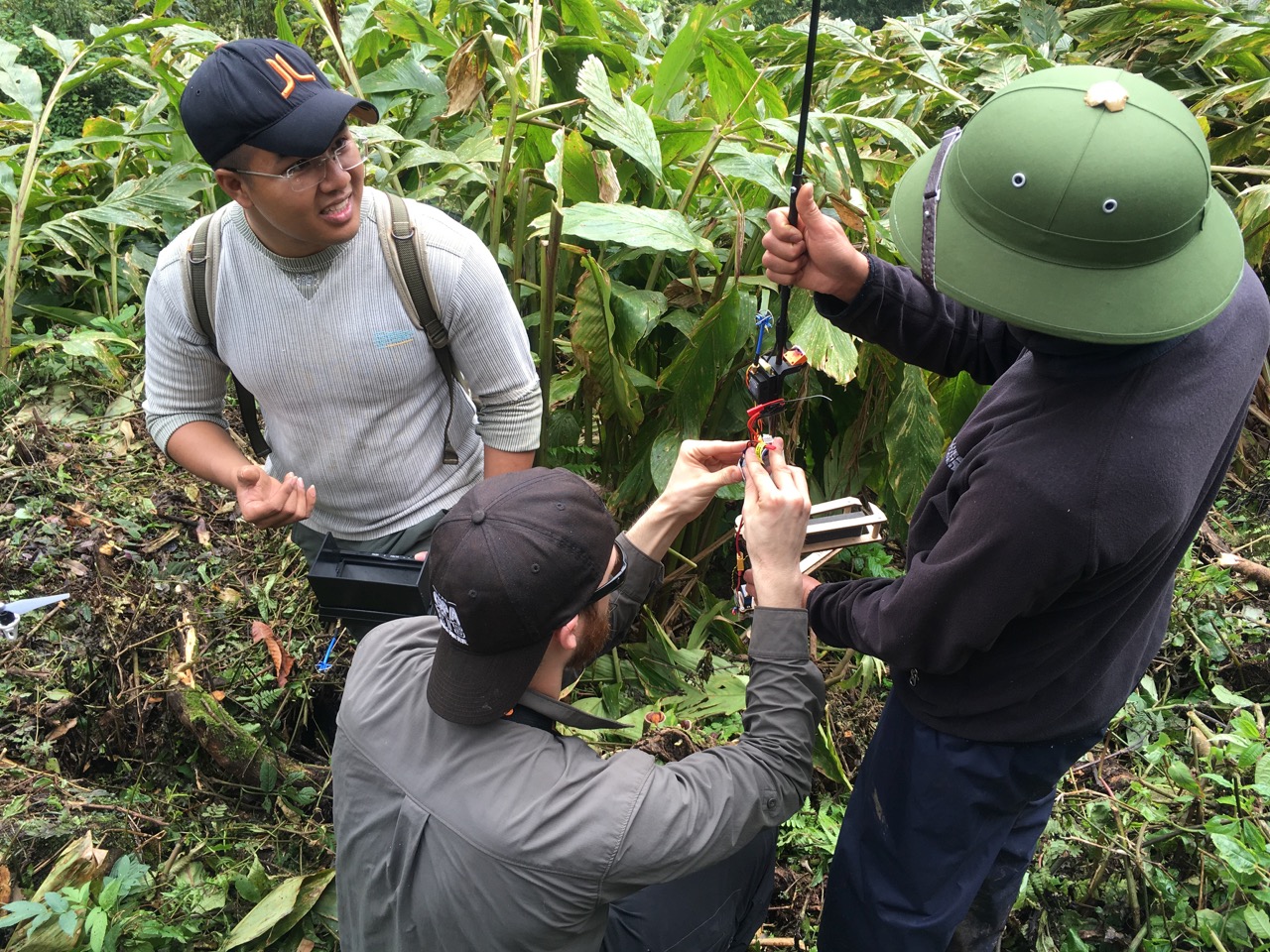
Son (left) and Uoc (right) assisting Thomas in preparing the drone cutting apparatus.
Once Thomas was ready, he flew the cutting drone up to the top of the horse chestnut and within a few minutes had manipulated the drone to successfully cut and grab a good-sized branch tip, but it was almost immediately obvious that it was without an inflorescence, so a second attempt was made. This time it was a success, and much cheering, clapping and back slapping followed. The fact that these trees typically produce their flowers at the tips of their branches and at an enormous height would have otherwise prevented the collection of flowering material. The only viable alternative would be to cut the tree or a significant piece of the tree down to access this material. It doesn’t take a botanist to see that cutting a branch with an inflorescence from a branch tip 25 m above the ground and delivering it intact into the hands of a group of enthusiastic plant collectors by remote control is a pretty remarkable achievement. Bravo Thomas. Bravo Alexis!
Day 10 (April 7)
We left early for the now famous cable-car ride called Fansipan Legend, which takes customers from a just outside Sapa Town to a landing just below the peak of Fansipan. The peak, as I noted in my 2016 Vietnam blog, is the highest in Indochina, at 3143 m (10,312 ft.). When we visited in 2016 the cable car had only been operational for about a month, and much of the development (hotel, temples, restaurants and parking infrastructure at the bottom, and buildings, temples, observation plazas, and restaurants at the top) had yet to be completed. This time, it was all there, and even much of the construction debris we had been concerned about, had been removed (or was grown over). Incredibly, there is even a newly minted light rail connection from downtown Sapa to “Hoang Lien Station” at Fansipan Legend. This opened less than a month ago.
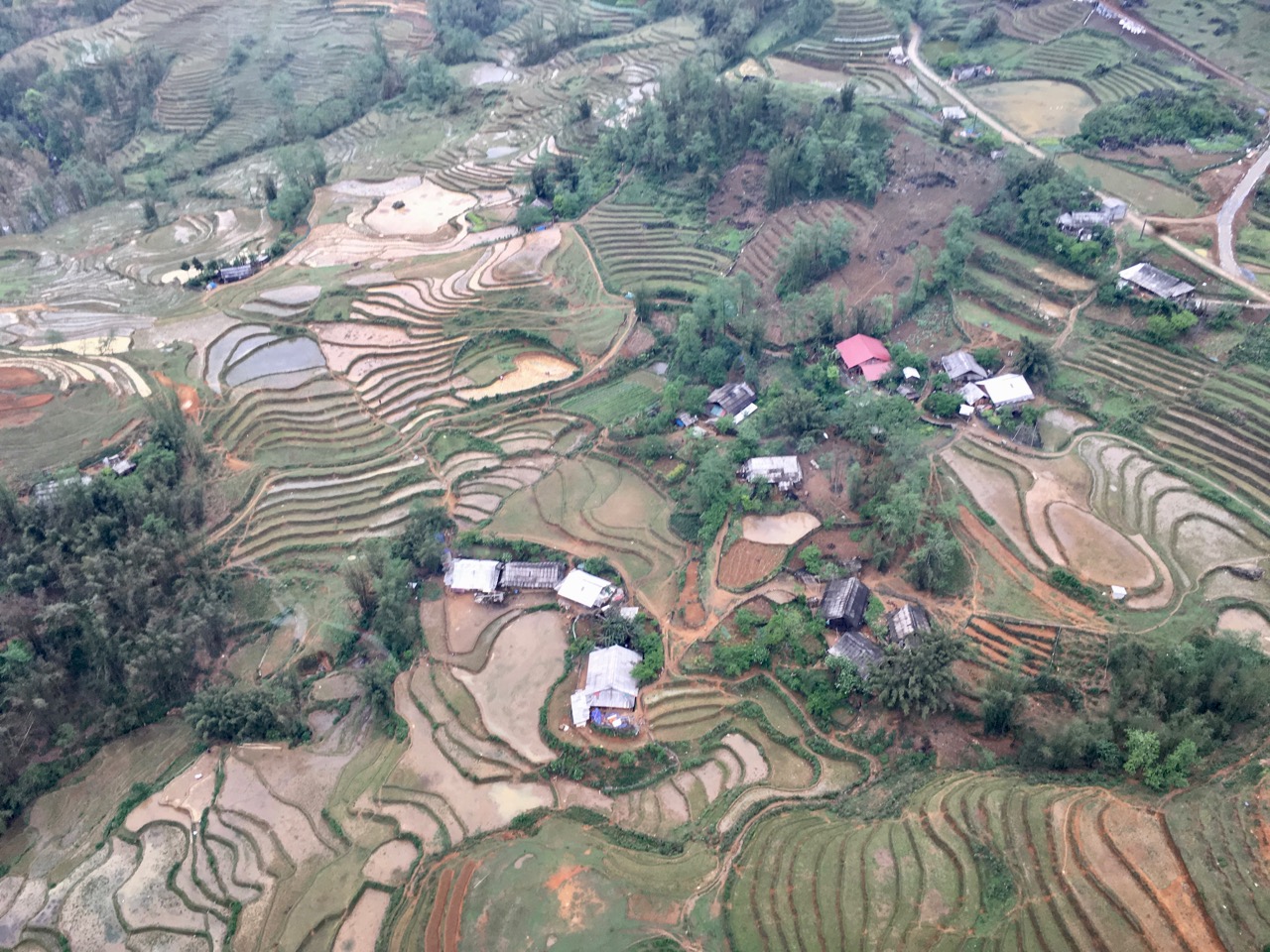
View from Fansipan cable car
Regardless of the transport used to get there, once on foot, navigating to the actual gondola site is fairly challenging. All customers have to thread their way through hundreds of official vendors’ stalls, gardens, displays and a colonnade. It’s definitely a visual assault and very cheesy in places, but most customers seem very excited to be here. Once inside the building, which is enormous, very fancy (all marble inside) and organized to effectively handle large groups, customers are loosely directed toward the queues for the gondola. On the way, there are several distractions—displays, restaurants, etc.—but we were on a mission and headed straight on. Our plan was to take the gondola to the top and walk the popular Tram Ton Trail down (a six- to eight-hour hike) to the Tram Ton Pass, which is about 10 km outside of Sapa. There we would rendezvous with our driver. The connection between the extensive development at the top of Fansipan and the trail system is somewhat tenuous. In the early days one got the sense that the people who ran the gondola and resort weren’t particularly interested in people hopping the fence to either join or leave the trails. I’m not sure if the situation is still the same because we never actually left the property at the top.
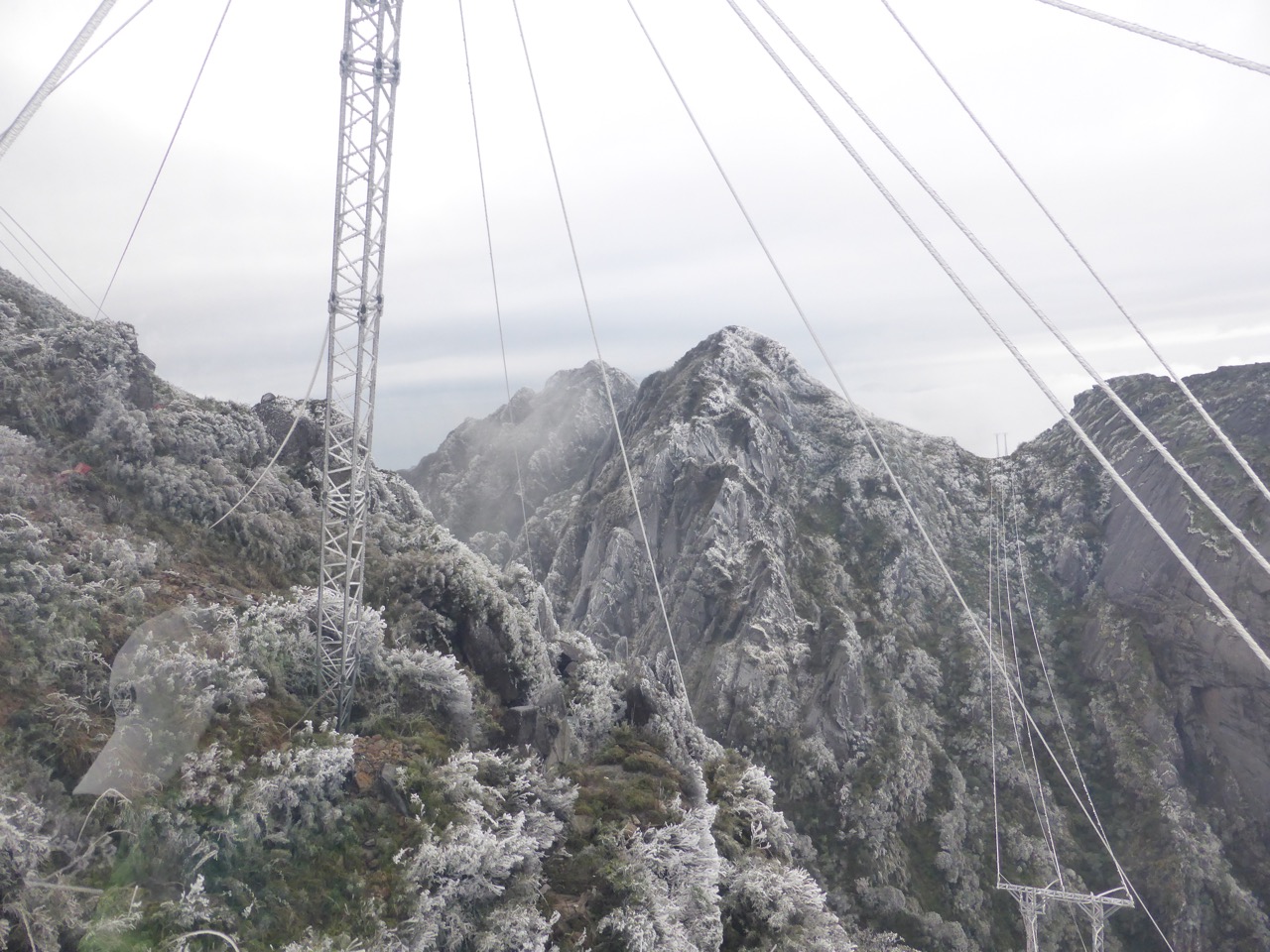
Ice storm on Fansipan
Our ascent was beautiful. There was mist shrouding the upper peaks and it was clear enough to distinguish individual trees below us as we glided upwards. At one point Maple Dan pointed out the huge conical inflorescences of what could only have been a Bretschneidera (a rare but distinctive flowering tree) far below. As we approached the top the mist gradually dissipated, revealing a strange white-covered realm. A number of the Vietnamese on board hooted excitedly, exclaiming “SNOW!” This was unexpected, but interestingly novel, and we all started to consider what kind of clothing we’d brought along for this trek. We were not ready for what came next. We stepped off the gondola into a deep freeze. There was ice on the floor and it was obvious the staff were cold and miserable. Into the building we trundled, then directly outside to ascend the large marble staircase to the observation plaza. As soon as we opened the door we were hit with a blisteringly frigid wind. The floor outside was a sheet of ice, as were areas of the stairs. We gingerly climbed the staircase, noting that the banisters were frosted as well. In fact, everything was coated not in frost, but in ice. Rhododendrons in flower that were planted by the stairway were frozen solid, the colour of the blooms muted by thick layers of ice. The temperature outside was well below freezing and there was a howling wind. This wasn’t snow or hoar frost; there had been an ice-storm. Hats flew and people shrieked in disbelief as they slipped and slid across the icy plaza. Our crew was mostly all dressed in boots, warm jackets, toques and gloves, and we were bloody freezing! Most of the Vietnamese customers were in trainers or sandals and with thin jackets or rain slickers. I can’t imagine how cold those people felt. We saw a number of people fall hard. We quickly decided to reconvene inside, where we thought better of traversing the expansive, bald granite slopes, fixed metal ladders and precipitous gulleys that characterize the top of Tram Ton Trail.
It was a lovely descent in gondola #17. On the way down we got a good look at the extent of the devastation, at least the lower reaches of the ice, which stopped abruptly less than 100 m below the station. Below this level, there were all kinds of plants, including rhododendrons in flower, undamaged. Lower down, because we were looking out for them, we noted at least three Bretschneidera trees (one with pink flowers, the others with white ones). Exiting through the gift shop, which was a bit like an IKEA (in that there was no obvious indication of an exit), we finally made it outside. We decided to head straight to Tram Ton Pass and hike from there, as far up as we could in the time we had left in the day.
The hike up Tram Ton was a pleasure. Whereas it had once been a seriously challenging ascent (as remembered by Dan Hinkley, who had hiked it numerous times), Hoang Lien Park staff have made numerous improvements over the intervening years. Crude steps have been cut into the more difficult sections of rock, well-spaced boulders have been placed throughout the wet areas and there is even an extensive boardwalk that skirts a stream. Even given our slow-poke, plant-collecting ways, we made excellent time and almost made the camp directly below the peak. There were all kinds of great plants and spectacular views and the IEBR crew made many collections including of beautiful flowering specimens of Acer laevigatum and A. campbellii affinity. Thomas made four separate flights with the fly cam at various points along the trail, his skill at creating beautiful, sweeping videos of the trees and countryside seeming to grow with each flight.
Day 11 (April 8)
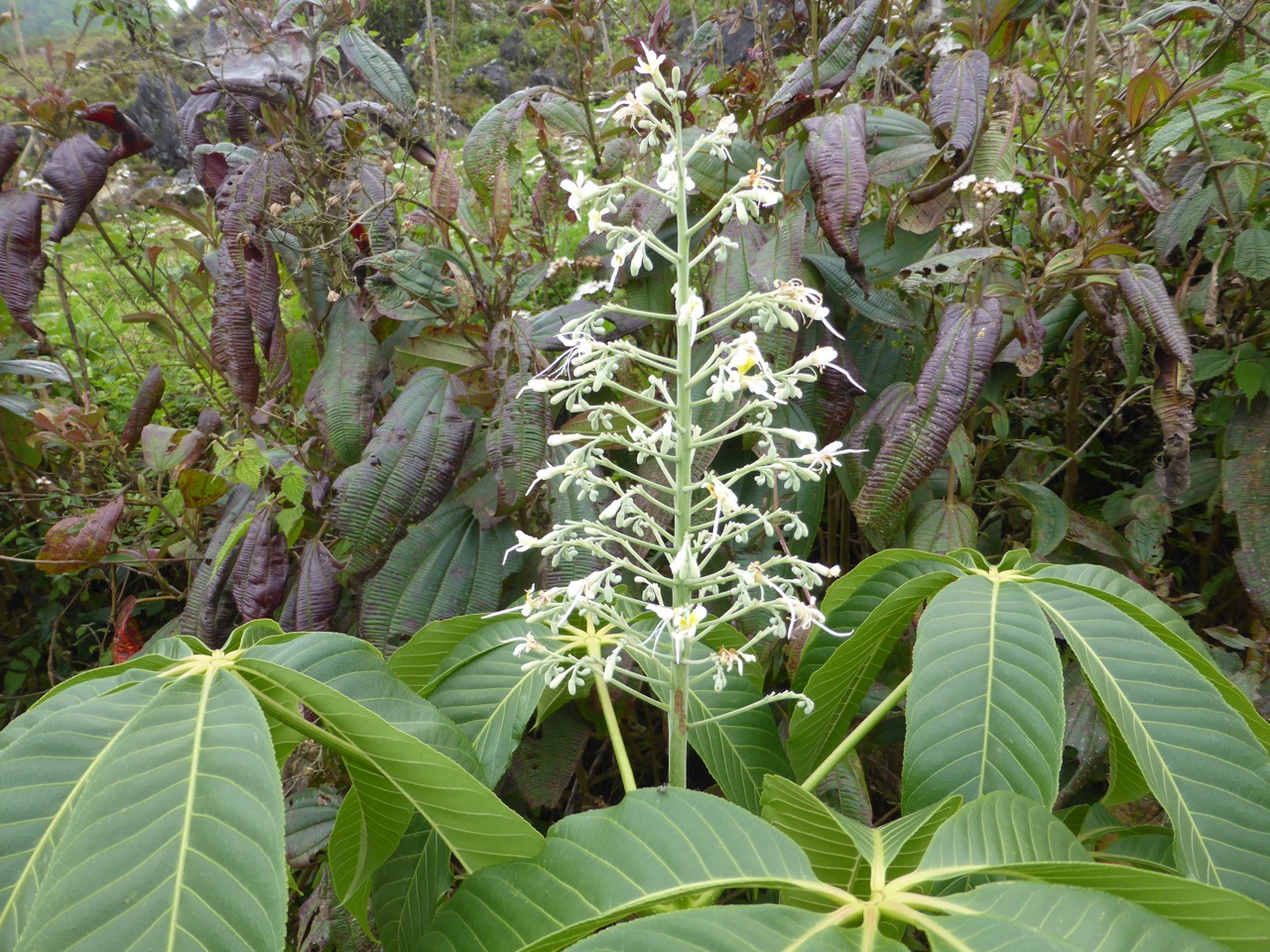
Aesculus assamica near Dragon’s Teeth, Sapa
Our destination today was Séo Mý Tỷ (pronounced see oh me tee), across the river from Sapa, about 25 km southeast of the peak of Fansipan. Instead of a fancy cable car, we all piled into our trusty van and headed down to the bottom of the valley. Although only a 10 km drive, it took nearly an hour because the road is so badly pot-holed and torn up. The elevation of Sapa Town is 1500 m, the valley bottom here, 1000 m, and our goal across the valley was any forested area above 1500 m, where we might find the elusive Acer fenzelianum (like A. tonkinense, but with slender branches and narrower leaves, and the shoots with shaggy hairs), and the even more mysterious A. pictum, which has an enormously wide distribution across east Asia, but has only been seen once in Vietnam. Both species had been previously collected by Dan Hinkley in this area, so it was our hope that he could lead us to specimens.
The road on this side of the valley was challenging, but more because it was a typical mountain road, navigable on foot or by motorcycles and four-wheel-drive and larger, heavy-duty vehicles. As we’d done previously, we contracted with a few of the motor-scooter-riding mountain boys and took turns walking and being shuttled up the mountain. Alas, the mountain—even within the National Park boundary—was mostly denuded of useful timber, and we watched as scores of scooters drove up the road, only to return some hours later laden with firewood. Neither maple species was ever located despite our best efforts. Sadly, it seems that this is going to be the pattern, even in so-called protected areas. However, it was a beautiful day and a number of collections were made. It also seemed the perfect conditions for the fly cam, but tragically, the drone crashed on its first flight. There was an apparent momentary loss of communication, enough for the drone to drop out of sight where it became caught up in some unforeseen tree or deep fern bed. Unfortunately, the terrain was exceedingly steep and the vegetation jungle-like. We spent some time trying to locate the drone, but the search was as fruitless as it was difficult and dangerous. Exhausted and discouraged, most of us ended up walking the six km or so down the mountain to the waiting van. Not our best day, but as Dan Crowley pointed out, we did see a few other things here that we know are at our next destination, Y Ty, so there’s hope for the missing maples to show up there. It was also pointed out that while we lost a piece of equipment, which was supremely disappointing, we all left the mountain in one piece.
Day 12 (April 9)
We stopped in Lao Cai on the way to Y Ty to meet Mr. Trunz, the new Director of the Bat Xat (pronounced baz-sat) Ecological Reserve. This is the reserve that we’d all been pressing for and it was certainly heartening to hear that the government had seen fit to both set it aside and create some administrative infrastructure. Y Ty is the name of the village to the west of the mountain. Nobody seems to be able to tell us the actual name of the particular mountain we’ve been exploring (we’ve all been calling it Y Ty), but a fair chunk of it has apparently been included in the reserve. One of the initiatives Mr. Trunz mentioned was the development of a 50-hectare botanical garden, and Du suggested that this was something we (UBC Botanical Garden) could be involved with. This was certainly food for thought. A number of us had been kicking this idea around as a means to maintaining the incredible biodiversity here. Constructing boardwalks around the site (part of the reason the site is so rich is that it’s wet), excluding grazing animals and restricting the cutting of firewood would be a good start.
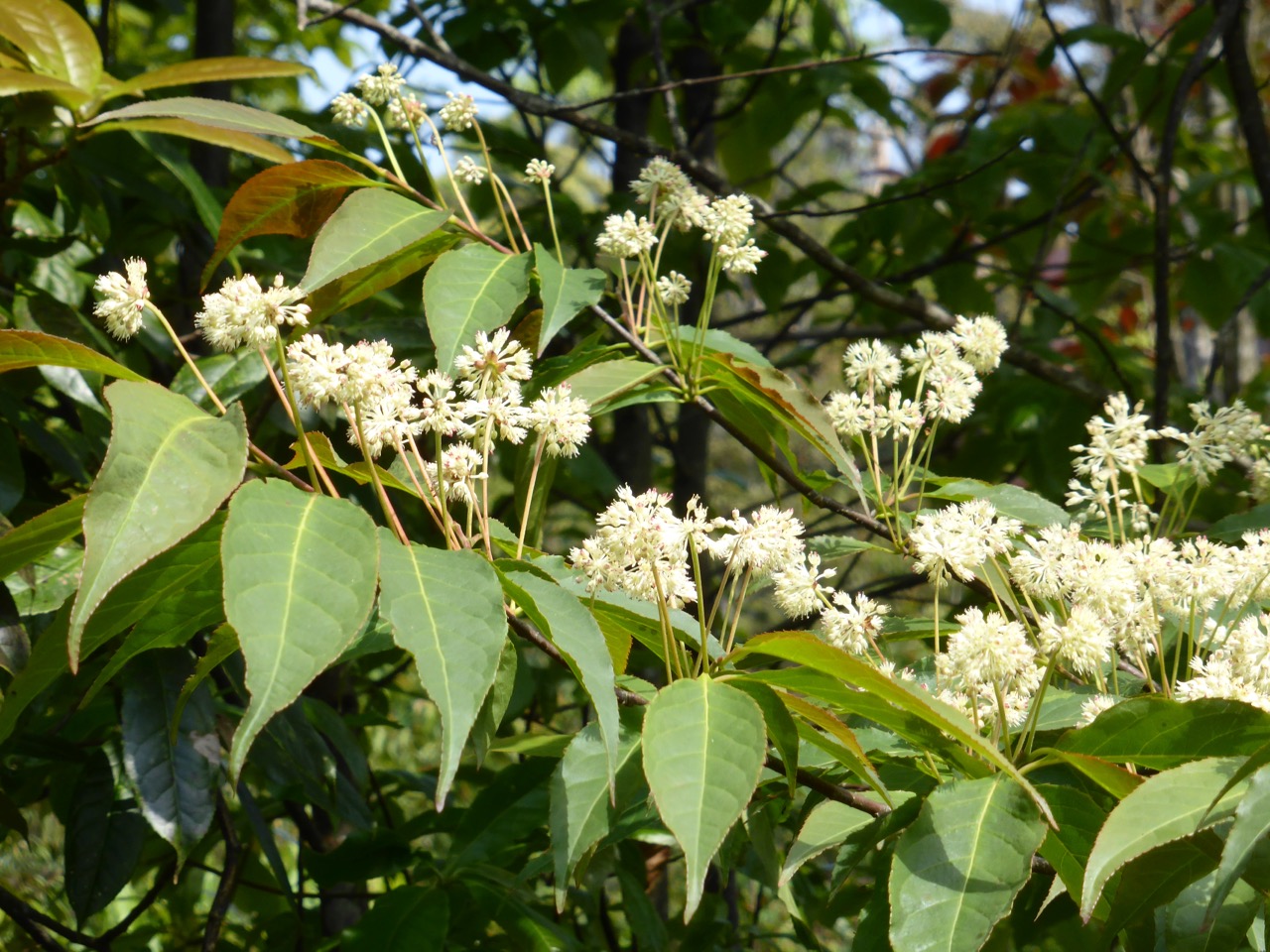
Dipentodon sinicus
On the way up, we stopped just short of Y Ty to check on the big (now famous) Bretschneidera sinensis. It was in full bloom, as it was the previous year and a stunning sight. Andy, Dan Crowley and I had a look around—always on the lookout for another specimen or something else of interest, but it was getting on. We were booked in to stay at a farm just up the road from the fish farm, which is the start of the trail up the mountain. Lunch (and all our meals) at the farm are in a brand new (since last year) construction brick building. There is a fire in one corner, some simple furniture and storage racks, and stacks of tiny plastic stools, which one sits/squats upon. This is the conventional seating arrangement practically everywhere (except in the bigger cities) and we’ve gotten used to perching on these low stools at most meals. I typically end up smashing my knees into some part of the table. It’s a fair question whether my knees are hurting because of the bruising, the constant squatting or the pounding downhill on our hikes.
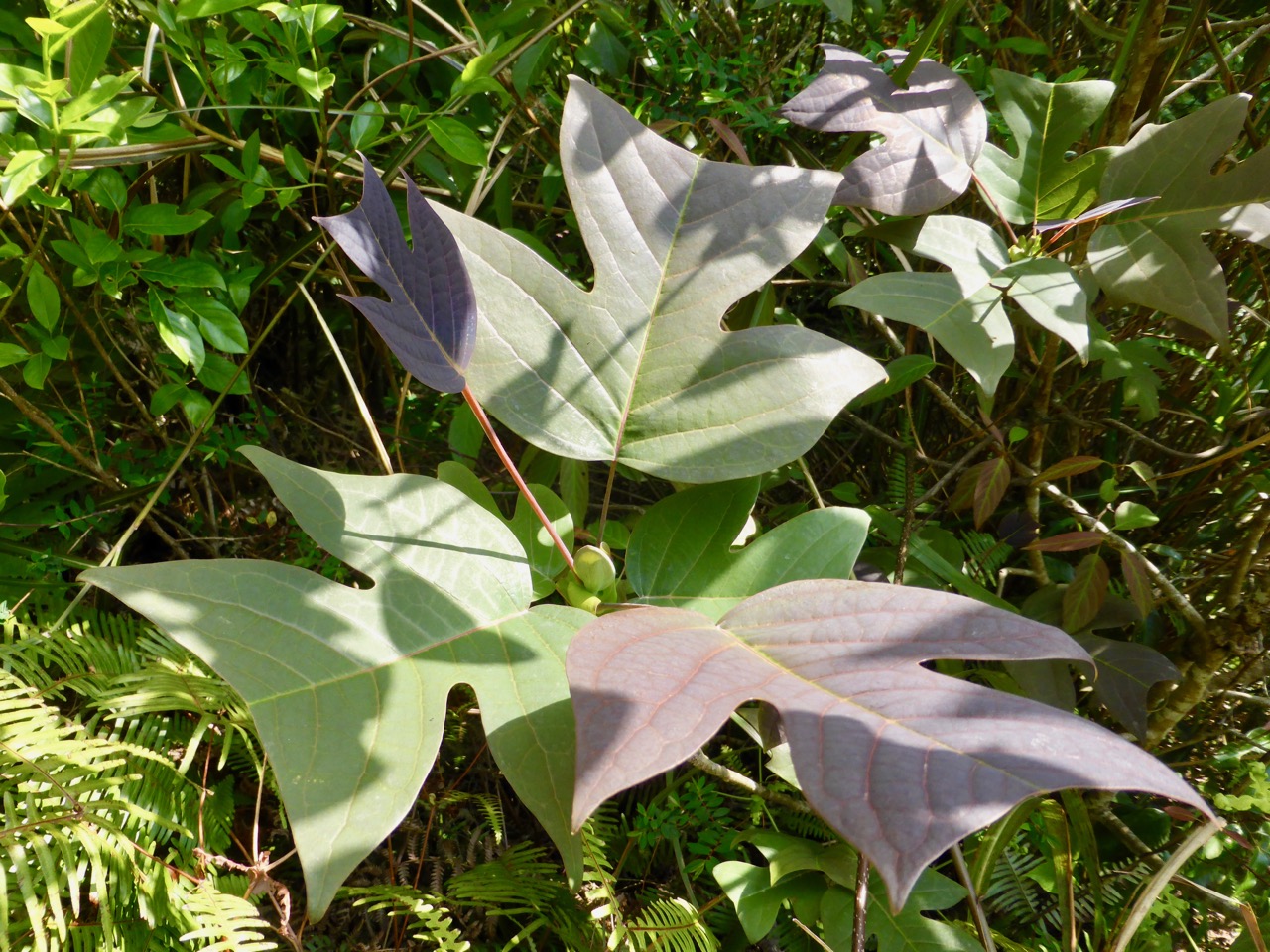
Liriodendron chinense
Today, we started our cataloguing above the road where we’d not collected extensively before. We quickly found a variety of interesting plants, including beautiful specimens of Fagus sinensis (Chinese beech), flower-laden Stauntonia yaoshanensis, S. brunoniana and a new-to-science Holboellia species (all evergreen Akebia relatives), stump sprouts of Liriodendron chinense with rich purple-brown new leaves (fast-growing trees like maples and liriodendrons are targets for woodcutters, so mature trees are seldom seen) and the deliciously fragrant Rhododendron moulmainense, which is growing epiphytically on all kinds of older tree trunks. There was a thought that continuing down the road we might drop in elevation sufficiently to find Acer fenzelianum, but after a few hours we were still well above 1700 m, the maximum elevation listed for any collection of the species, and it was so hot out on the road (nearly 30 C) that we had to turn back. Quite a change from a few days earlier on Fansipan.
Day 13 (April 10)
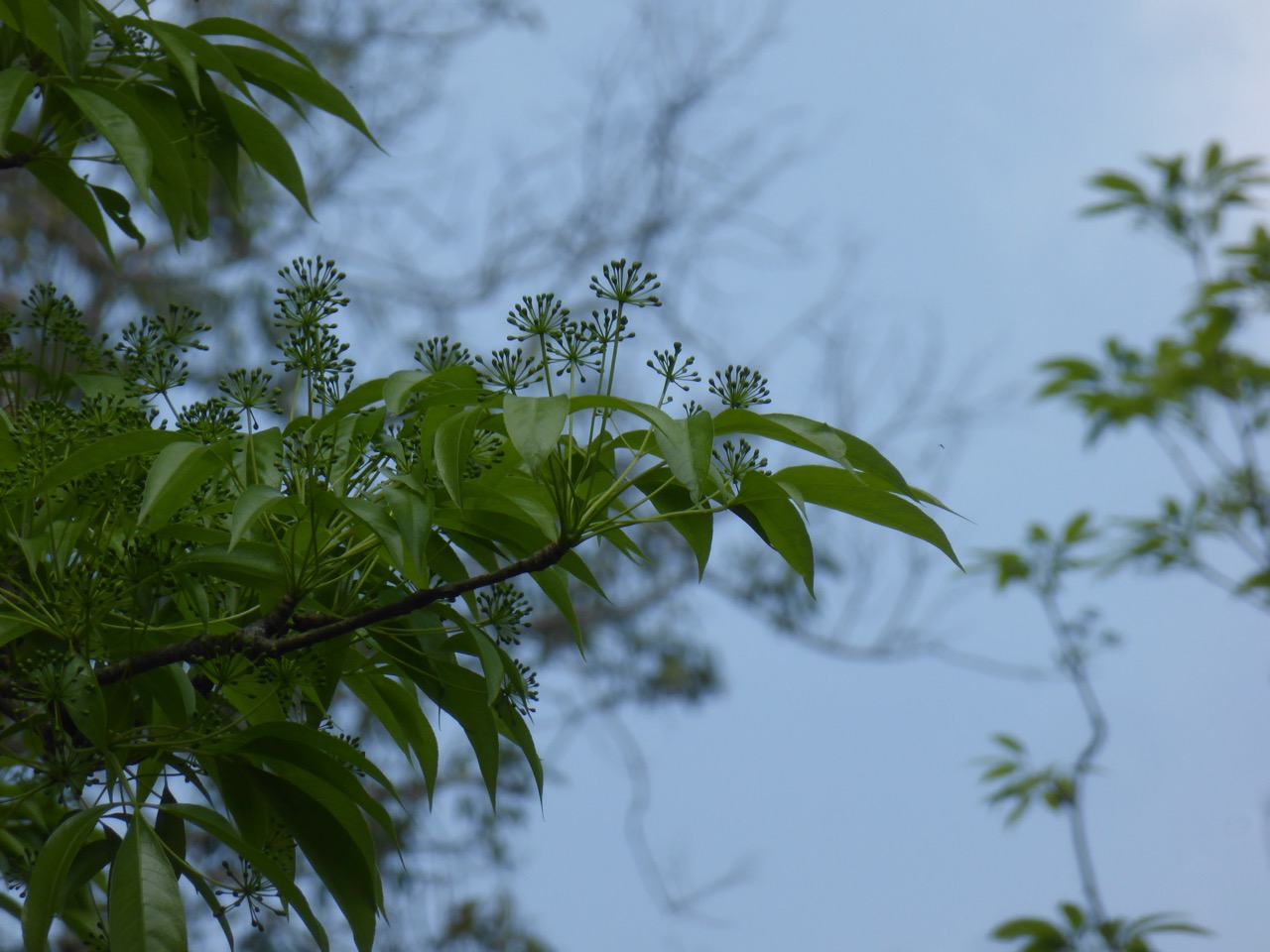
Macropanax sp.
Today was a proper hike. We started at the fish farm with the same barking dogs we all knew from the previous two years. The mutts hurl themselves at the fence and bark menacingly, but the open gate is only a few feet away and they never venture outside. So we skirt the fence with the dogs leaping and snarling along until we pass from their view. We more or less follow a water line (a 12-inch-diameter iron pipeline) that originates in a stream high on the mountain. Today in our zeal to collect some old dried-up seeds of the rare Rhoiptelea chiliantha (which probably won’t germinate anyway), we got off the main trail and mistakenly continued on another trail. In this area we saw a massive, ancient Fagus sinensis (30 to 35 m tall) and a number of beautiful aralids. There seem to be quite a few poorly characterized members of the Araliaceae (ginseng family), including a large, exceptionally attractive tree what we think is a Macropanax species. We had gained about 200 m elevation before discovering our mistake and eventually turning back. Our farmer host, Mr. Dzec, who was accompanying us and acting as a porter, said nothing when we started following the wrong path, but I suppose he probably thought we knew what we were doing. To save us some time, however, he led us on a “shortcut,” which was mostly down a broad, steep stream bed with incredibly slippery rocks. Of course, all 4′ 5” of him in his rubber boots is honed for just such an excursion. I doubt he’d slip on ice. The rest of us were lucky to have made it without falling or getting soaked.
We stopped at a cardamom-drying shack for lunch, then continued heading up the hill, slogging up and down the narrow, muddy track. Andy reported seeing a near-metre-long snake, evidently black with blue-green back. It crossed the path between Du and Andy, mere seconds after I had passed. Further entertainments included (after an hour of breathless upward exertion and considerable sweat) seeing about a half dozen enormous Tsuga dumosa (Himalayan hemlock) trees, which are probably several hundred years old, and scores of gigantic Betula insignis var. fansipanensis (Fansipan birch). We saw plenty of this same birch, although much smaller, at lower altitudes, as well. The species can be recognized by the strong wintergreen aroma of its cut stems, and the subspecies by its neat purple-bronze new leaves with contrasting paired cream-coloured stipules—stipules are small, leaf-like bracts that accompany the emerging leaves of some species. The hemlock, on the other hand, is probably threatened. We saw no seedlings, despite there being cones in the trees and on the ground. Chances are that there are other T. dumosa trees and seedlings at higher altitudes, but the absence of regrowth around such mature trees suggests that the environment has changed significantly since they themselves germinated. With climate change, the hemlock’s ideal growing zone, like other temperate species will gradually rise in elevation until it runs out of mountain.
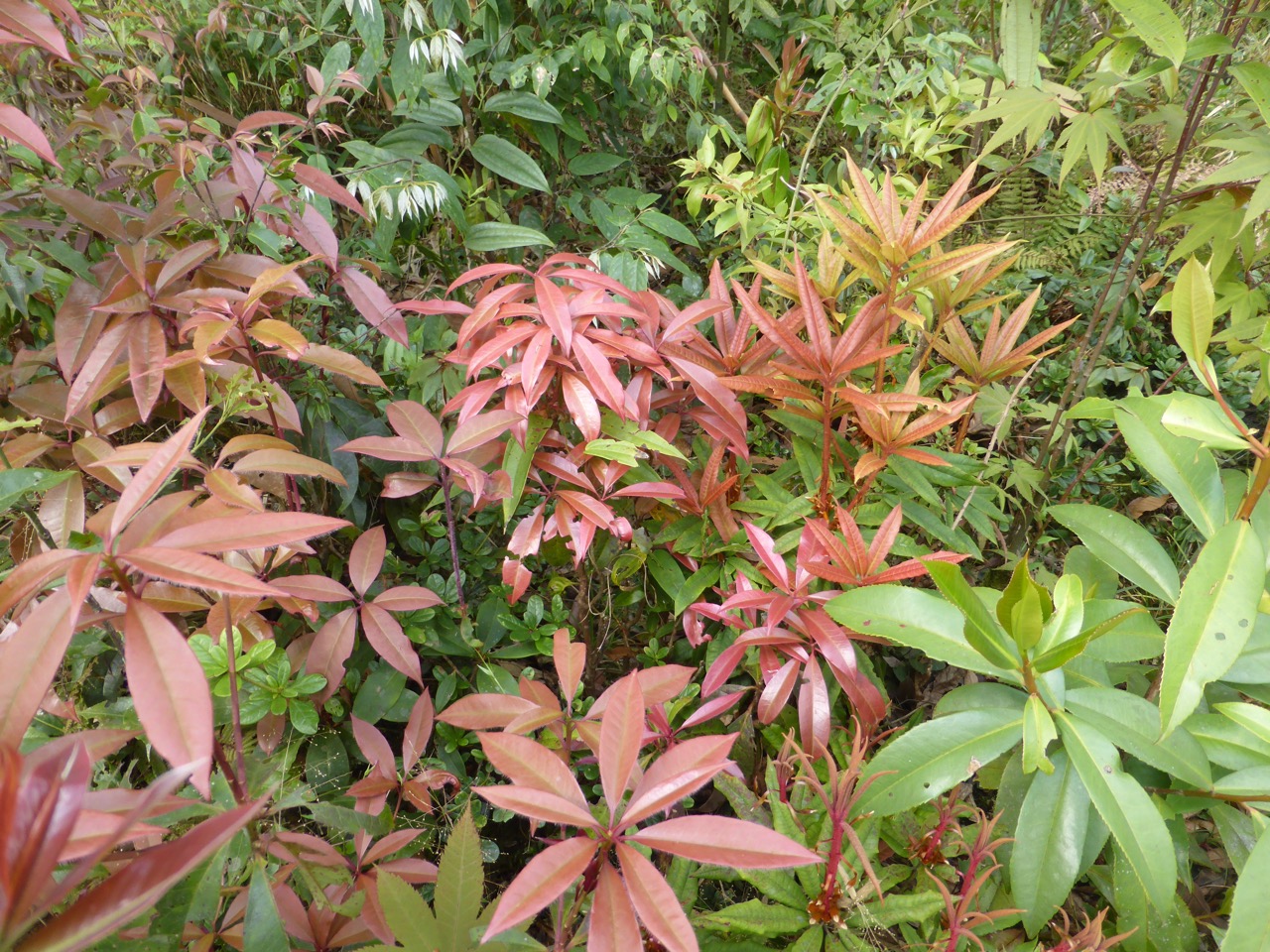
Rhododendron moulmainense
At this height (around 2000 m), rhododendrons were becoming increasingly common, with many different kinds represented. Unfortunately, we saw few in flower, but most rhododendrons are attractive with or without flowers. Many of the smaller species and also some of the larger ones were either epiphytic (often on older magnolias) or growing in moss atop the flat, sloping granite outcrops. The largest-leaved species that we saw, R. suoilenhense, has leaves 45 cm long by nearly 30 cm wide. We saw some specimens, well out of reach, that were at least 6 or 7 m tall. These were by no means the tallest rhododendrons, as we walked by numerous tree-sized R. moulmainense at various elevations that were more than 15 m tall, and saw plenty of what we assume were R. fansipanensis of a similar size. We finished the day back at the farm. After three years of visits to Y Ty, walking by the barking dogs and following the pipeline that feeds the fish farm, we finally got to try the fish, which are fresh-water, pen-raised salmon (Atlantic salmon by the look and taste). In preparing them, the fish had fresh cardamom inserted into slashes in the flesh and were wrapped in cardamom leaves while cooking. Mr. Dzec evidently learned the technique from the multi-talented Uoc Huu Le. It was a singularly delicious and a fitting end to our time at Y Ty.
Day 14 (April 11)
We left the farm and Y Ty briskly after a traditional breakfast of meats, vegetables, eggs and rice, saying our farewells to our wonderful hosts. As we had neglected the forests in this area below 1700 m elevation, we thought we might have a shot at seeing Acer fenzelianum somewhere along the road. Today would be our last opportunity to collect anything in the wild, so there was quite a bit riding on a sighting. We piled out of the van when we got to around 1700 m and walked for a few kilometres downhill, but again, we were shut out. Another couple of hours on the road (all the while scanning, scanning…) and we were back in Sapa Town. We decided that since Sapa is the type locality for A. fenzelianum (where the species was characterized), we’d have better luck investigating the hills around town. We enlisted Uoc to help us find a tree. He was happy to oblige, having grown up in Sapa and knowing the location of a couple of trees.

Aesculus assamica
After lunch, we all jumped into the van for a short ride across town. Uoc showed us a back alley that turned into a paved trail and within a few minutes, we were standing looking at A. fenzelianum. The trouble was, we were looking at a large stump immediately beside a serious road construction. Time for Plan B. Uoc then led us up the other side of the road and up the mountain overlooking Sapa. Up and up we went. Much of the mountainside forest—at least that which was in sight of Sapa—has been decimated to make room for houses and agriculture. The pressure on the land here is overwhelming. We got to the top of the hill to the area known as the Dragon’s Teeth (so named because of the large, exposed karst-limestone outcrops), and saw nothing that we could characterize as untrammeled land. Anyway, at 1760 m, this was well above where we would expect to see A. fenzelianum. We were all coming to the conclusion that if A. fenzelianum had been in the Sapa area, it was no longer here. Somewhat disconsolate, we continued over the ridge to where Uoc promised a huge remembered specimen of Aesculus assamica. But this too had apparently been cut down. It was all pretty bleak until Uoc showed us a handful of large, healthy horse chestnut seedlings in a little hollow some distance below where the “mother plant” had grown. We were further elated to find a sizeable tree in full flower. In retrospect, our experience this day seemed pretty emblematic of the state of biodiversity in northern Vietnam. The bounty that was described by plant collectors only a few years before was gravely threatened, quickly disappearing or already gone. Unbridled development, the ever-increasing cutting of wood and removal of rare plants from the wild, the overwhelming quantity of plastic and chemical debris and especially the wholesale conversion of forests to agriculture are all having a devastating effect on the environment and a catastrophic effect on biodiversity. Clearly, the tangible benefits to people living now, and the short-term economic profits that are obviously being generated are considered more important than any effort at organized, society-wide attempts at conservation. At least, this is how it seems.
Day 15 and 16 (April 12, 13)
After a travel day from Sapa to Hanoi, we were reinserted into the Danly Hotel. This time I was not above taking the elevator to my eighth-floor room, although I noticed that Thomas was still gamely bounding up and down the staircase. The mere consideration of this I find exhausting. Well, good for him—but I need a rest.
We had a scheduled meeting with Fauna and Flora International (FFI) on Friday morning. This was ostensibly to discuss our ongoing work in northern Vietnam and to find out whether there was overlap with FFI-initiated projects in the area. It turns out that most of FFI’s work is concerned with endangered animals (this is where the money is, evidently). In particular, the western black-crested gibbon and the Tonkin snub-nosed monkey (very cute) are getting most of their attention. The Global Trees Campaign (GTC) (a partnership between FFI and Botanic Gardens Conservation International) had previously done some work in northern Vietnam, most recently starting in 2010 assessing the conservation status of a number of Magnolia species. This was followed up in 2013 with a GTC-supported project to propagate endangered magnolias in nurseries for re-introduction into the wild.
The FFI Country Director, Josh Kempinski, expressed considerable admiration for the scientific integrity of the IEBR, and was very positive about our work in cataloguing plants in the Hoang Lien area. We discussed the current state of plant biodiversity in northern Vietnam, in particular in and around the Hoang Lien mountains, and the factors impacting conservation; e.g., climate change, cardamom production, conversion of forests to agriculture, wood cutting, and other pressing issues. We discussed the potential of using drone technology for surveys and collecting, and the opportunities for identifying charismatic trees species (e.g., Bretschneidera, Aesculus) to help promote conservation. We left the meeting somewhat buoyed. We got a commitment from Josh that FFI would help to connect us with partners and potential funders and continue to discuss with us the ultimate goal of building a program around a broad, landscape-based approach to conservation in this area.
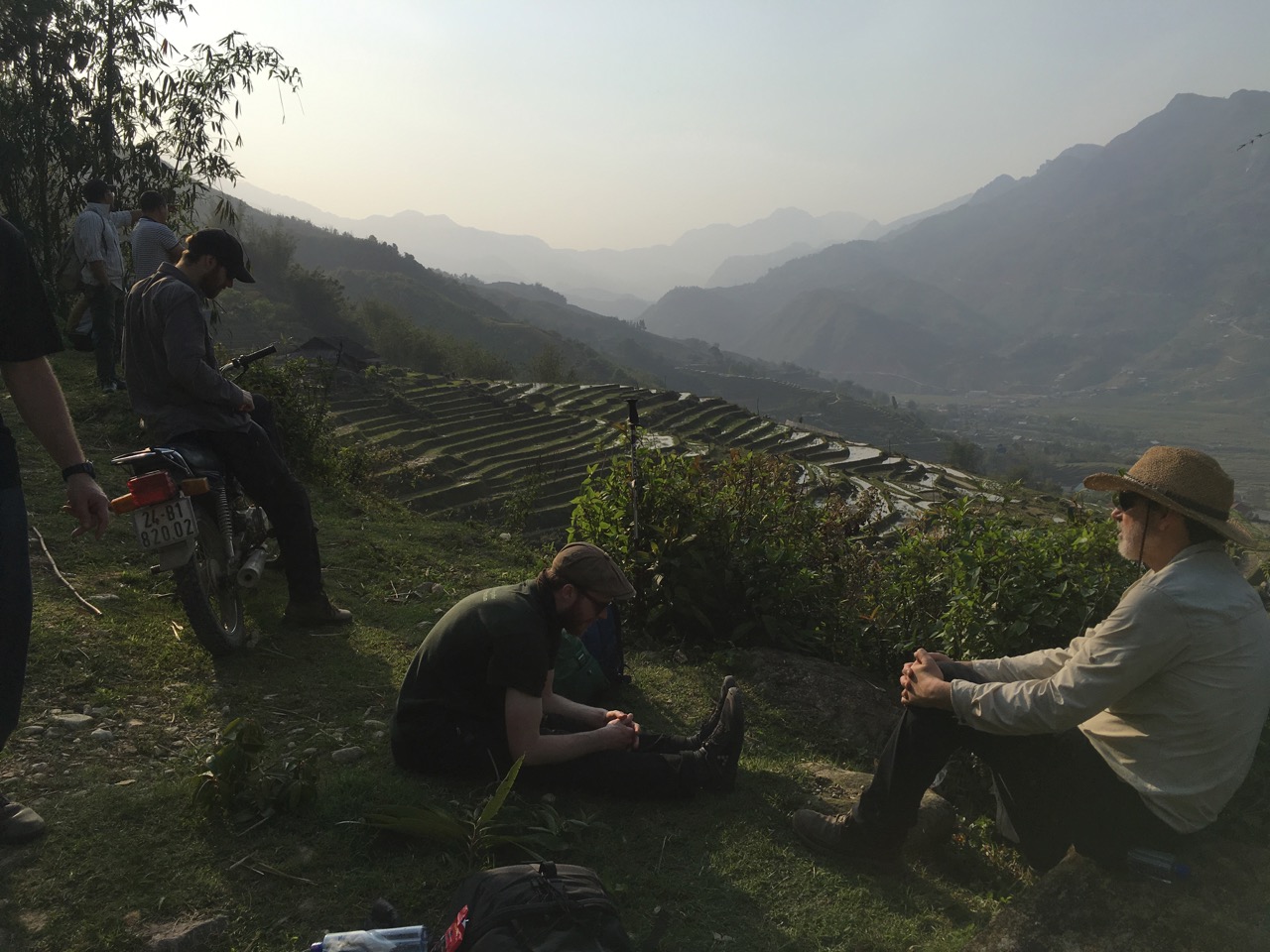
Submitted by: Douglas Justice, Associate Director, Horticulture and Collections Published May 2, 2018.

Thanks for your feedback. I’ll pass it along to Douglas Justice the author of the post. You’ve given me an idea- perhaps we can share some “throwback” photos from this and other collecting trips on our Instagram account over the winter. Stay tuned to https://www.instagram.com/ubcgarden !
Very exotic. Great pics… love to see more pictures…